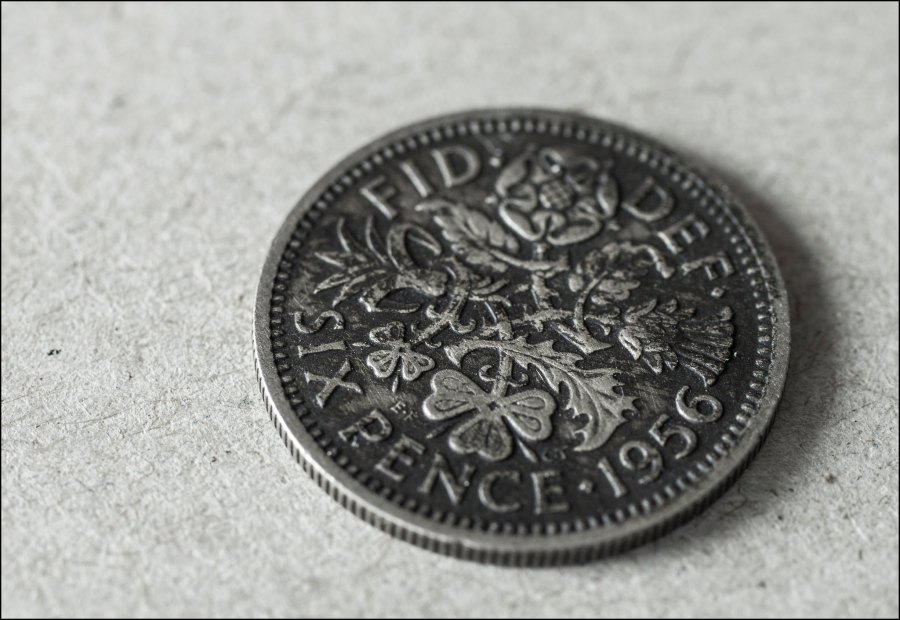What Is a Sixpence in US Currency?

A sixpence coin was part of the British “old money” system, which refers to the way British money was divided before 1971. Using the last full year of the “old money” system, a sixpence coin would be worth .35 British pounds today, which converts to about 46 cents in American money.
How Did the ‘Old Money’ System Work?
The British “oId money” system was in effect for centuries, from the time of the Norman Conquest in 1066 until the United Kingdom adopted a new monetary system based on tens that went into effect on February 15, 1971. Under the “old money” system, the British used three currency units: pounds, shillings, and pence (or pennies). A sixpence coin was worth six pennies, or sixpence. A shilling equaled 12 pence, and 20 shillings made a pound, meaning there were 240 pence in a pound.
Some historians and experts on money argue that the “old money” system was easier to use than the new system because it was easier to divide pounds into fractions, which was easier for businesses before the use of calculators. However, the U.K. began the switch to a decimal system in 1968 and had completely changed over by early 1971.
Coins Under the ‘Old Money’ System
The British had a wide array of coins under the “old money” system. A farthing represented a fourth of a penny, while a halfpenny (or ha’penny) was half a penny, as its name suggests. They had one penny coins as well as threepence coins. Farthings, halfpence, pence, and threepence were all made from bronze.
Larger coins in this system included the sixpence, shilling, two shillings, and half crown, which was two and a half shillings. These coins were made from silver, as was the crown, which was five shillings and only issued for special occasions.
Switching to a New System
In 1968, the British government announced that they would begin transitioning to a new system of currency that had 100 pence per pound and no shillings. The next year, they began issuing new five pence, 10 pence, and 50 pence coins so people could get used to the new system when it debuted in 1971. At first, many British were worried about the confusion that a new system would cause, but the people got used to it quickly.
As the country transitioned to the new decimal system, the government slowly phased out the old coins, except for one ― the sixpence. As businesses moved over to the new system, a sixpence coin became worth two and a half new pence. Consumers who had old coins rounded amounts up to the nearest sixpence and received their change in new pence coins, which allowed British citizens to move smoothly to the new system.
Current British Money
Today’s British currency system uses eight coins and four paper notes. The British use one penny, two pence, five pence, 10 pence, 20 pence, 50 pence, one pound, and two pound coins. They also have five, 10, 20, and 50 pound paper notes. Modern British coins are mostly copper, with varying amounts of zinc and nickel in them. Of course, many British are moving toward credit and debit cards, contactless cards, and phone payment systems and relying less on cash, just like Americans do.
Currency Exchanges and How They Work
At the beginning of this article, you read about how what a sixpence coin would be worth in American money. To know the difference between currencies in different countries, we have to rely on the currency exchange rate. Exchange rates tell you how much it’s worth to swap your money with a foreign currency when you go overseas or buy something in a foreign currency. For example, at a given moment, 1.3 Great British pounds could be worth one United States dollar.
Exchange rates change constantly, although they usually don’t fluctuate by large amounts. International traders exchange currencies 24 hours a day, seven days a week, and their trades, along with the strength of each country’s economy, determine the exchange rate at any given moment. A few countries have fixed exchange rates that never change. When you travel internationally, you have to pay attention to the exchange rate to know how much money you’ll be able to trade your dollars and cents for.





